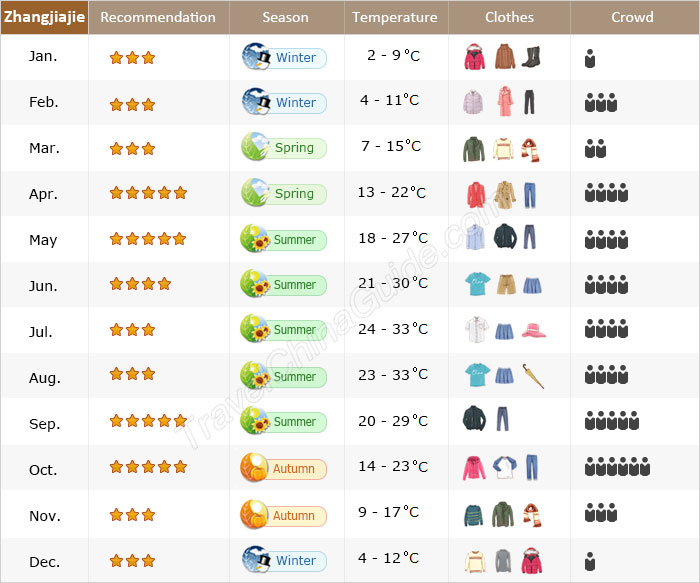
When is the Best Time to Visit Zhangjiajie?
Zhangjiajie, home to the awe-inspiring scenery that inspired the movie Avatar, is a year-round destination. However, the best time to visit Zhangjiajie is during the shoulder seasons:
- Spring (April to June): Experience warm weather, blooming flowers, and fewer crowds.
- Autumn (September to October): Witness the stunning autumn foliage transforming the landscape into a vibrant masterpiece.
Why Spring and Autumn are the Best Times to Visit Zhangjiajie
Here's a breakdown of why spring and autumn are considered the ideal times to visit Zhangjiajie:
Spring (April - June)
- Pleasant weather: Spring in Zhangjiajie offers comfortable temperatures ranging from 15°C to 25°C (59°F to 77°F), making it ideal for hiking and outdoor activities.
- Blooming flowers: Witness the beauty of rhododendrons and other wildflowers in full bloom, adding splashes of color to the already stunning landscape.
- Fewer crowds: While still a popular time to visit, spring sees fewer tourists compared to the peak summer months, allowing for a more tranquil experience.
Autumn (September - October)
- Spectacular foliage: Witness the breathtaking transformation of the landscape as leaves turn vibrant shades of red, orange, and yellow. The autumn foliage in Zhangjiajie is truly a sight to behold.
- Comfortable temperatures: Similar to spring, autumn offers pleasant weather with temperatures ranging from 15°C to 25°C (59°F to 77°F), making it ideal for outdoor exploration.
- Clear skies: Autumn often brings clear skies and excellent visibility, providing stunning panoramic views from the mountain peaks.
Other Seasons in Zhangjiajie
While spring and autumn offer the most ideal conditions, here's what to expect during the other seasons:
Summer (July - August)
- Hot and humid: Summer in Zhangjiajie can be hot and humid, with temperatures reaching up to 35°C (95°F). Be prepared for occasional rainfall and pack accordingly.
- Crowded: Summer is peak tourist season in Zhangjiajie, so expect large crowds, especially during weekends and holidays.
- Lush greenery: The landscape is lush and vibrant during summer, offering a different kind of beauty compared to the colorful foliage of autumn.
Winter (November - March)
- Cold and snowy: Winter in Zhangjiajie is cold and often snowy, with temperatures ranging from -5°C to 10°C (23°F to 50°F). Be sure to pack warm clothing.
- Fewer crowds: Winter sees the fewest tourists, offering a more peaceful and secluded experience.
- Unique winter scenery: Experience the magic of Zhangjiajie transformed into a winter wonderland with snow-capped peaks and frozen waterfalls.
Zhangjiajie Climate Information
Here's a table summarizing the climate information for Zhangjiajie throughout the year:
| Season | Months | Average Temperature (°C) | Average Rainfall (mm) |
|---|---|---|---|
| Spring | March - May | 12 - 20 | 40 - 80 |
| Summer | June - August | 25 - 32 | 100 - 200 |
| Autumn | September - November | 15 - 25 | 30 - 60 |
| Winter | December - February | -2 - 8 | 10 - 30 |
FAQs about the Best Time to Visit Zhangjiajie
What is the cheapest time to visit Zhangjiajie?
The cheapest time to visit Zhangjiajie is typically during the winter months (November to March) when tourist numbers are at their lowest. However, be prepared for cold weather and potential snowfall.
What should I pack for a trip to Zhangjiajie?
Pack comfortable walking shoes, as you'll be doing a lot of hiking. Bring layers of clothing to accommodate for temperature changes, especially if you're visiting during spring or autumn. Don't forget essentials like sunscreen, insect repellent, and a hat.
How many days do I need to see Zhangjiajie National Forest Park?
To fully experience Zhangjiajie National Forest Park, it's recommended to allocate at least 2-3 days. This will allow you to explore the main attractions at a leisurely pace and soak in the breathtaking scenery.